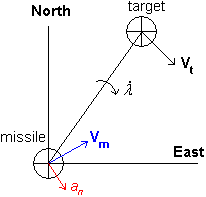Proportional navigation
Proportional navigation (also abbreviated to PN or Pro-Nav ) is a guidance method that is used in most modern guided missiles . It takes advantage of the fact that two objects moving linearly at constant speed are on a collision course if and only if the bearing does not change.
The course must therefore be corrected in such a way that the target can always be seen in the same direction in relation to your own missile (α and β constant in the image on the right). For this, the speed vector must change proportionally to the speed of rotation of the connecting line between the missile and the target.
Here, the acceleration perpendicular to the velocity vector of the missile, is a dimensionless proportionality constant, the rotational speed of the connection line and the speed of the missile.
In vector notation, the acceleration can be calculated as follows:
with the speed of rotation of the connecting line :
This simple principle was used in first generation guided missiles, e.g. B. in the AIM-9 Sidewinder , still implemented in analog technology . Modern missiles extend this process with algorithms for predicting the flight path of the target.
Individual evidence
- ^ Neil F. Palumbo et al .: Basic Principles of Homing Guidance. (PDF; 3.4 MB) Accessed December 6, 2012 .
- ↑ George M. Siouris: Missile Guidance and Control Systems . ISBN 0-387-00726-1 .









